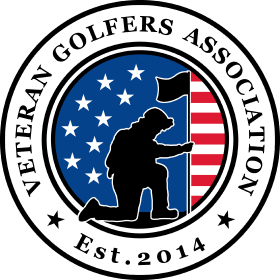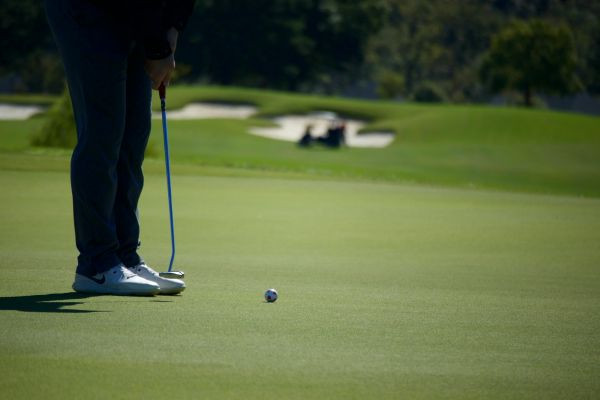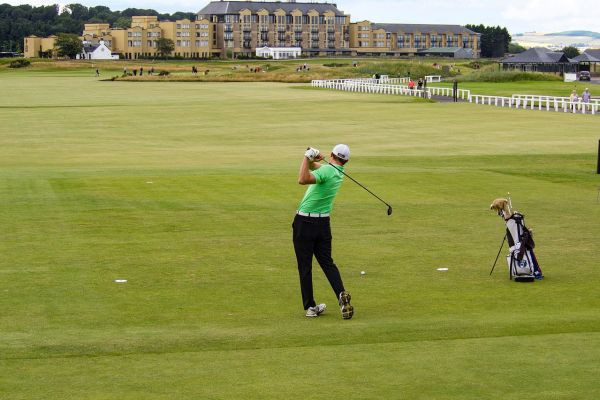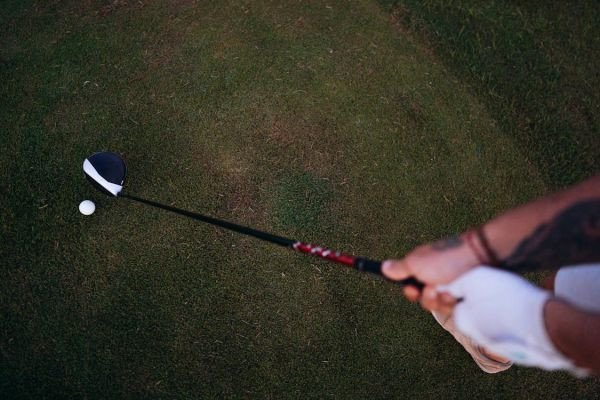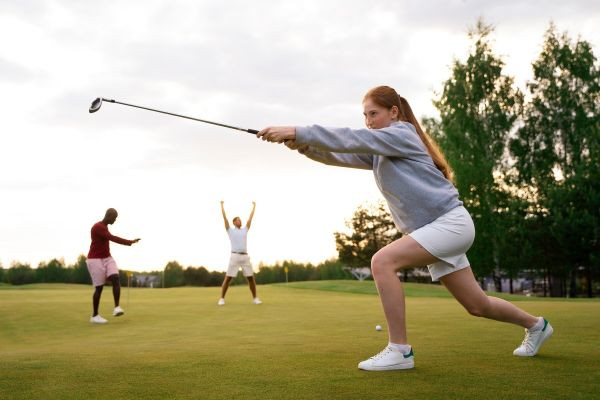Conquering the Challenge of Pull Shots in Golf
A pulled golf shot is one that launches left of your intended target and maintains that trajectory until landing. While these shots might feel satisfying and cover significant distance, they lack the ..

A pulled golf shot is one that launches left of your intended target and maintains that trajectory until landing. While these shots might feel satisfying and cover significant distance, they lack the precision necessary for positioning the ball near the hole.
Does this resonate with you?
If pulling shots is a challenge you face, I'm here to guide you on how to eliminate this issue from your golf game. I'll share with you some of my most effective tips and techniques. More crucially, you'll gain insights into the reasons behind your pulls, enhancing your understanding of your own play and improving your decision-making on the course.
What Exactly is a Pulled Shot in Golf?
Let's start by getting an understanding of the laws of ball flight to get a better idea of why the golf ball goes where it does. But first, let's clarify what a pulled shot is in golf.
A pulled shot in golf for a right-handed golfer happens when the ball starts left of the target and keeps moving left. It doesn't curve, as it flies straight, but in the wrong direction. Variations of a pulled shot include the pulled slice and the pulled hook.
Ball Flight Laws
To understand why golfers hit pulls, or any shot that misses their target, you must first have a grasp of the flight laws of the golf ball.
How golf swings are analyzed nowadays has changed dramatically, mainly thanks to the latest in technology. However, for a good while golf teaching was based mainly on the "Old Ball Flight Laws". These old ball flight laws led instructors to believe that the path of the club dictated the initial direction of the ball and the clubface only caused the ball to curve.
What was found from golfers who use technologies such as Trackman and many others are the "New Ball Flight Laws". However, have you heard about these new ball flight laws of late? The biggest change to the flight law beliefs is that it's been discovered that the position of the clubface at impact, relative to the target line, has the greatest influence on the starting direction of the golf ball.
Pull Slice: This occurs when the clubface is closed relative to the target but open compared to an outside-to-inside path.
Pull Straight: Here, the clubface is closed to the target but square to an outside-to-inside path.
Pull Hook: In this case, the clubface is closed relative to the target and also closed to a straight path.
Understanding the Causes of a Pulled Shot in Golf

Source:https://www.freepik.com/free-photo/professional-golfer-bali-indonesia_10496384.htm
According to the new ball flight laws that we just went over, the main reason for a pulled shot in golf is caused when the clubface is closed concerning the target line.
When the club face hits the ball which is closed in comparison with the path, the combination of clubface path and the out-side in swing or "over-the-top" swing creates a pull.
But what causes a golfer to have a closed clubface at the point of impact? And what causes the swing path to be diverted from out to in?
Well, let's go through these to help eliminate the pulls, pull hooks and pull slices from your game.
Wrist and Forearm Movements on a Closed Clubface in Golf
Before delving into the reasons behind a clubface closing at impact, it's vital to understand certain key movements of your wrists and forearms during the swing.
Here's a basic guide to wrist positions that could influence your golf swing:
1. Flexion and Extension
Flexion: Simply put, this is when your wrist is bowed, bringing your palm downward towards the ground.
Extension: This occurs when your wrist is cupped, raising your palm upwards towards the sky.
2. The Role of Radial and Ulnar Deviation
Radial Deviation: In layman's terms, this refers to bending or hinging your wrist upwards towards your radial bone.
Ulnar Deviation: This involves bending or hinging your wrist downwards, towards your ulnar bone.
3. Pronation and Supination in Golf
Pronation: In golf, this means rolling your lead forearms towards the target, turning your palm upwards to face the sky.
Supination: Conversely, this involves rolling your forearms away from the target, with your palm moving downwards to face the ground.
When the clubface closes during the downswing, and at the time of your point of impact. Then you might have your lead wrist in extension. You would want your lead wrist at the time of your point of impact to be leveled with the flat, and sometimes even a little bowed.
Pronating your lead forearm early around your downswing into the moment of your strike can cause it. There's a great video where Eric Cogorno discusses the lead arm's supination, along with the mechanics of it, its timing, and reasons behind it, so check that out for a bit more understanding.
Strong Grip in Golf
Having a strong grip could cause your clubface to close prematurely as well. Therefore Striving for a neutral grip is crucial. This ensures your hands work together during your swings properly.
Mainly a neutral grip causes both your left-hand, and right hands to strike into the ball in perfect square, which is essential for your shooting accuracy and constancy.
Adjusting to a Neutral Grip
Shift to a more neutral grip by focusing more on where your thumbs and index fingers 'V' land. Both the 'V' formed by your right and left hand should point towards the middle of your trail shoulder. This would help you stabilize your grip and move your club face throughout the swing.
Remember, the grip is your only solid contact with the club, and is also your biggest feel while hitting the ball. Always keep an eye on it, and adjusting it regularly is crucial. You can see that your game improves quite a bit if you regularly modify your grip.
Addressing Issues with Ball Position in Golf
The placement of the ball is an important fact that plays into your shots. The incorrect ball position may lead to your shot's impact, losing its quality. Moreover, where the ball starts off on the hole, it was not your intended objective. When the ball is placed very far forward or middle, the usual result is a pulled golf shot. With the ball this far forward, the clubface is starting to close at this point in the golf swing. This means that by the time the club completes the golf swing, the clubface isn't square, resulting in striking the ball on the left side for right-handed golfers.
It's essential to find the optimal ball position for each club in your bag. This position varies depending on the club you're using - drivers, irons and wedges all have different ideal ball positions. Generally, for most mid-irons, the ball should be positioned roughly in the center of your stance, gradually moving forward for longer clubs.
Alignment in Golf
At times, what you perceive as a pulled shot might actually be a straight shot that's misguided due to poor alignment. Surprising, isn't it? If you're aligned too far left of your target (for right-handed golfers), even a well-struck shot will veer off course.
Alignment is a fundamental aspect of your pre-swing setup and plays a pivotal role in the outcome of your shots. While many golfers understand its importance, the tendency is to overly focus on swing mechanics, often overlooking this crucial element.
In reality, a significant number of issues, including pulled shots, can be effectively addressed by simply refining your pre-swing fundamentals. Ensuring correct alignment is one of these key components. It's about aligning not just your feet, but also your hips and shoulders parallel to the target line.
Even seasoned professionals consistently return to these basic principles when they encounter difficulties in their game. Regularly checking and adjusting your alignment can lead to substantial improvements, often more so than complicated adjustments to your swing mechanics.
Outside-to-Inside Swing Path in the Downswing
In the downswing an outside-to-inside swing path results in a position where the golfer swings the club slightly out-inside out known as the over the top swing.
As we studied in the golf ball flight laws the outside-to-inside swing path causes the ball to start its trajectory left of the target. We can recall from this that the ball starts moving left of the target.
The three-ball drill which describes the correct inside-to-out swing path for the ball is used for practice; however sometimes a golfer's club strikes the ball resulting in shots that do not head towards the target.
Aside from the ball flight laws discussed, this swing path enables the golfer to attack the ball from inside to out which will increase power on the shots. The significant process in hitting a pure draw comes along with the perfect motion of outside to inside swing.
An over-the-top motion often starts at the initiation of the downswing when the golfer positions the club below an imaginary line extending from the ball to the target. Pulling the club down results in a wide variety of shots.
Strategies to Stop Pulling Shots
1. Emphasizing Pre-Swing Fundamentals
As previously mentioned and as championed by the world's top golfers many swing issues originate from poor pre-swing fundamentals. To minimize common problems like pulling the ball it's imperative to pay close attention to the following aspects:
Grip: A well-balanced neutral grip is essential along with maintaining appropriate grip pressure. It's crucial that both hands work in tandem to control the club effectively.
Posture: Adopting a strong athletic posture is key. This involves maintaining good balance and even weight distribution. Your stance should be stable yet flexible allowing for a full range of motion throughout the swing.
Alignment: This is a vital element in playing proficient golf. Generally for right-handed golfers your body should be aligned parallel left of your target line. This alignment includes not just your feet but also your hips, shoulders and eyes. Ensuring correct alignment can drastically improve the accuracy and consistency of your shots.
2. Pre-Shot Routine and Checklist in Golf
Establishing a consistent pre-shot routine is essential for any golfer aiming to improve their game. Top golf instructors emphasize this practice to their students as a critical step towards hitting better shots. This routine is a fundamental part of the game as important as any technical aspect of the swing.
While the significance of a pre-shot routine might be underestimated by some, the world's best golfers would attest to its crucial role in their success. A pre-shot routine helps in mentally preparing for each shot ensuring a golfer is focused, confident and physically ready to execute the shot. Padraig Harrington a renowned golfer has spoken about the impact of a pre-shot routine on performance.
This routine should include a checklist of key elements such as alignment grip stance and visualizing the intended shot. It's not just about physical preparation but also about getting into the right mental state. By following a consistent pre-shot routine golfers can achieve a more focused and disciplined approach leading to improved performance on the course.
3. Wrist Angle Management in Golf
It has been established that the wrists especially in their role of controlling the clubface are pivotal in influencing the ball's trajectory at impact. Thus for golfers looking to rectify issues with pulling shots mastering control over the clubface is a key area for improvement.
One effective method to enhance this control is by focusing on wrist angles during the swing. A valuable tool in this endeavor is the HackMotion wrist sensor. This device provides insightful biomechanical feedback enabling golfers to understand and improve their wrist movements throughout the swing.
The importance of having accurate real-time feedback on wrist positions cannot be overstated. It helps in identifying and correcting flaws that might lead to inconsistencies in shots. Utilizing a HackMotion wrist sensor can be a transformative step in a golfer's journey towards better control and precision.
4. Adapting the Justin Rose Drill for Improved Swing Path
Justin Rose Drill is a very popular method of how the top of your swing falls into place for a swing path to direct the club to. Professional golfer Justin Rose while performing the drill showcases by keeping his lead arm close to his chest advocating himself for creating a steeper hand path and subsequently shallower clubhead path. Also Just Rose practices the drill as a means to establish a swing with the most accurate swing path for the club.
The method devised by Justin Rose is not meant just for professionals but it is helpful for you if you struggle to keep the clubhead inside and out. An average golfer does follow the over-the-top path while the swing is being directed to hit the ball which subsequently ruins the clubhead performance.
The drill shared by Justin Rose manifests the lead arm's proximity to the chest rather than getting separated explicitly. As you swing the club or your arm to hit the ball make sure the lead arm brushes your chest lightly.
For amateurs who find hitting from a stall on the driving range with Justin Rose's Drill there is an alteration to the drill. Substitute your body for the alignment stick and visualize swinging out to the right and missing your target; then send the ball toward the target with a proper swing path as per Rose's drill.
5. Two Ball Gate Drill
This final technique is a practical drill you can easily implement on the driving range requiring no special training aids, just two extra golf balls. The Two Ball Gate Drill is a straightforward yet highly effective method to refine your downswing path and reduce the tendency to pull the ball.
To set up this drill place one golf ball just to the right of the ball you intend to hit, positioning it about an inch outside the toe of your club. Then position a second ball slightly ahead of the ball you're hitting but on the heel side.
Spacing the balls like this somewhat creates a 'gate' through which your clubhead should pass as you swing into an impact. Moreover after inserting the tees you can easily go to the top ball smoothly. So the setup encourages a more accurate path. Certainly it's easy to set up and its improved controls can help overcome the 'over the tops.
As you get better at the drill you can increase the difficulty. By merely narrowing the 'gate.' This is done by merely narrowing the 'gate.' Reposition the inner tees even closer and your path needs to be more accurate. Further the drill won't only assist you to end pulls but also improves your limit of control and precision.
Conclusion
Enduring the agony of pulled shots can be extremely disheartening in golf. As is the case with every challenge met by golfers it is essential to comprehend the inevitable causes and effects of the problem for effectively implementing the solutions.
This article aimed at building a crystal-clear idea of what a pulled shot is and why it may happen. This is the first and foremost step to take a pulled shot out of your game.
We have discussed five tips in the article for getting rid of pulled shots. These tips target specific areas of improvement in which can eliminate pulled shots. By regular practice you can erase pulled shots permanently from your game. It is essential for you to understand your swing mechanics and practice constantly to bring about the desired change and hike up your performance at the golf course.
Be patient and practice consistently to keep pulled shots far removed from your game. This will lead to an excellent golfing experience for you.
Frequently Asked Questions (FAQ)
What is a Pulled Shot in Golf?
A pulled shot in golf and for a right handed golfer starts out left of the intended target and carries out straight further left. Hence without curving back the golf ball loses its trajectory and stays left of the right. On a golf course when hitting the shot with an iron or wood especially with a driver a golfer should hit the golf ball in a way that it approaches close to the hole.
How Do the New Ball Flight Laws Affect Understanding Pulled Shots?
The New Ball Flight Laws as taught by technology like Trackman has clarified that the clubface's position at impact to the target line determines the initial direction the ball takes. However, its direction is determined by the swing path concerning the clubface. So, when correcting and managing pulled shots, understanding this is vital.
Why is Wrist and Forearm Movement Important in Preventing Pulled Shots?
The forward and back, sideways movement of the wrist and forearm during the downswing plays a crucial role in the clubface's position at impact. Being able to expertly flex and extend radially and ulnar deviation, as well as pronations and supinate the wrist can make the end trajectory of the shot precise.
How Can a Neutral Grip Help in Preventing Pulled Shots?
When hands form a neutral grip, they can work together perfectly. The neutral grip is essential when returning the clubface squarely to the ball at impact. When the thumbs and index fingers make a 'V' when gripping the club, it can be changed to point to the center of our trailing shoulder.
What is the Purpose of the Two Ball Gate Drill?
The Two Ball Gate Drill is for refining the downswing path to avoid hitting pulled golf balls in play, most likely hindering you from performing to your satisfaction. This RA method of practicing a gate swing requires developing a sense of touch in a different part of the body just to hit the ball right.
